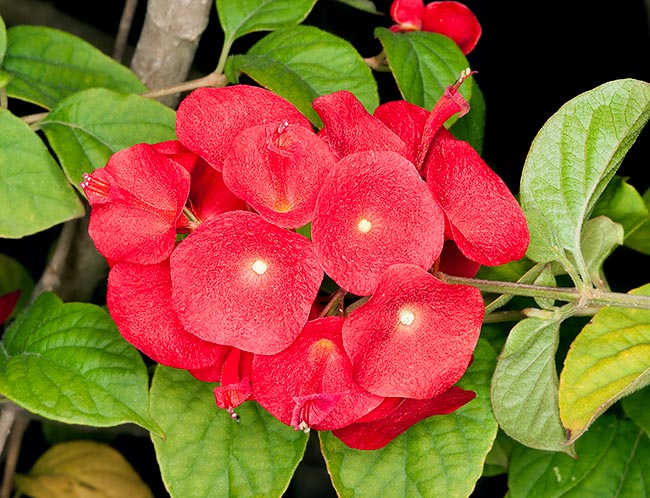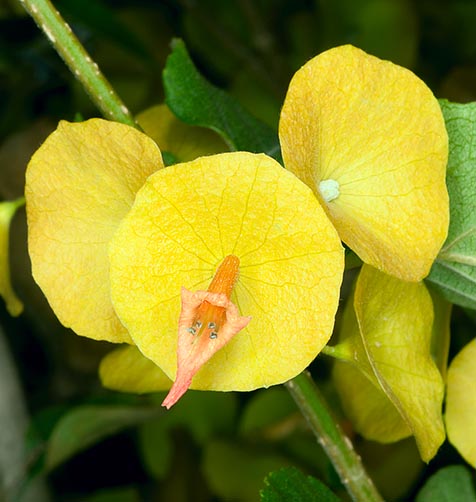Family : Lamiaceae

Text © Pietro Puccio

English translation by Mario Beltramini

Holmskioldia sanguinea is a 5 m tropical shrub with odd inflorescences © Giuseppe Mazza
The species is native to Arunachal Pradesh, Assam, Bhutan, Darjeeling, Himachal Pradesh, India, Jammu Kashmir, Myanmar, Nepal, Sikkim and Uttaranchal, where it grows on the slopes of Himalaya between 900 and 1500 m of altitude.
The genus is honoured to the Danish botanist Johan Theodor Holmskiold (1731-1793); the name of the species is the Latin adjective “sanguineus, a, um” = of bloody colour, with obvious reference.
Common names: Chinaman’s hat, Chinese hat plant, cup-and-saucer-plant, hat plant, mandarin’s hat, parasol flower (English); chapeau chinois (French); cappello cinese (Italian); chapéu-chinês, chapéu-chinês-amarelo, chapéu-chinês-vernelho, chapéu-de-mandarim (Portuguese); bonete chino, paraguita chino, platillo, sombrilla china (Spanish).
The Holmskioldia sanguinea Retz. (1791) is a woody evergreen shrub up to about 5 m tall, with long arcuate branches, being the young ones slightly pubescent and of almost quadrangular section. The leaves are opposite, ovate or deltoid with long pointed apex, slightly pubescent, 5-12 cm long and 3-8 cm broad, with entire or slightly dentate margin of dark green colour. Inflorescences in axillary or terminal cymes, up to about 5 cm long, carrying flowers from orange to red (in cultivation there is also a yellow flowered variety), with petaloid calyx shaped like an ample bell with 5, slightly pronounced, lobes of about 2 cm of diameter, persistent, tubulous corolla, 1,6-2 cm long, bent downwards, with 5 lobes with curved margins and bigger front lobe.

The 2 cm corollas may be red, orange or yellow © Giuseppe Mazza
The fruits are obovoid drupes with 4 lobes, 0,5-0,8 cm long, of brown colour with persistent calyx. It reproduces by seed, which germinates usually in 1-3 months at the temperature of 20-22 °C, air layering and by woody cutting in spring in sandy soil.
Vigorous species cultivable in full sun in the zones with tropical, subtropical and marginally warm temperate climate, where the temperatures just under the 0 °C are a short lasting exception, temperatures in the range of -3/-4 °C destroy the aerial part, but it can grow again from the base in spring; it adapts to different types of soil, even if poor, provided well drained, with regular waterings in summer.
It flowers for several months per year, also for the long time persistent petaloid calyx, the most conspicuous part of the flower, after the fall of the corolla; even when cut the flowered shoots are long lasting and then can be utilized in the floral compositions. Of rather disorderly appearance, if left free to grow, with appropriate and constant prunings, which do not cause prejudice to the flowering, on the contrary, do stimulate it, it can be grown in various forms, from small tree to isolated shrub as a barrier, furthermore, thanks to the long and flexible branches, it can be used also as semi-climber, leaning on trellises and gates.
Where the permanent cultivation in open air is not possible, due to climatic reasons, it can be cultivated in pot, utilizing a rich and draining soil, but must be sheltered in a very luminous location during the colder months, with lowest winter temperatures not under the 10 °C.
Synonyms: Hastingia coccinea Sm. (1806); Holmskioldia rubra Pers. (1806); Platunum rubrum A.Juss. (1806); Holmskioldia scandens Sweet (1826); Hastingia scandens Roxb. (1832); Holmskioldia sanguinea f. citrina Moldenke (1961); Holmskioldia sanguinea f. aurantiaca Yin Yin Kyi & DeFilipps (2003).
→ To appreciate the biodiversity within the family LAMIACEAE please click here.
